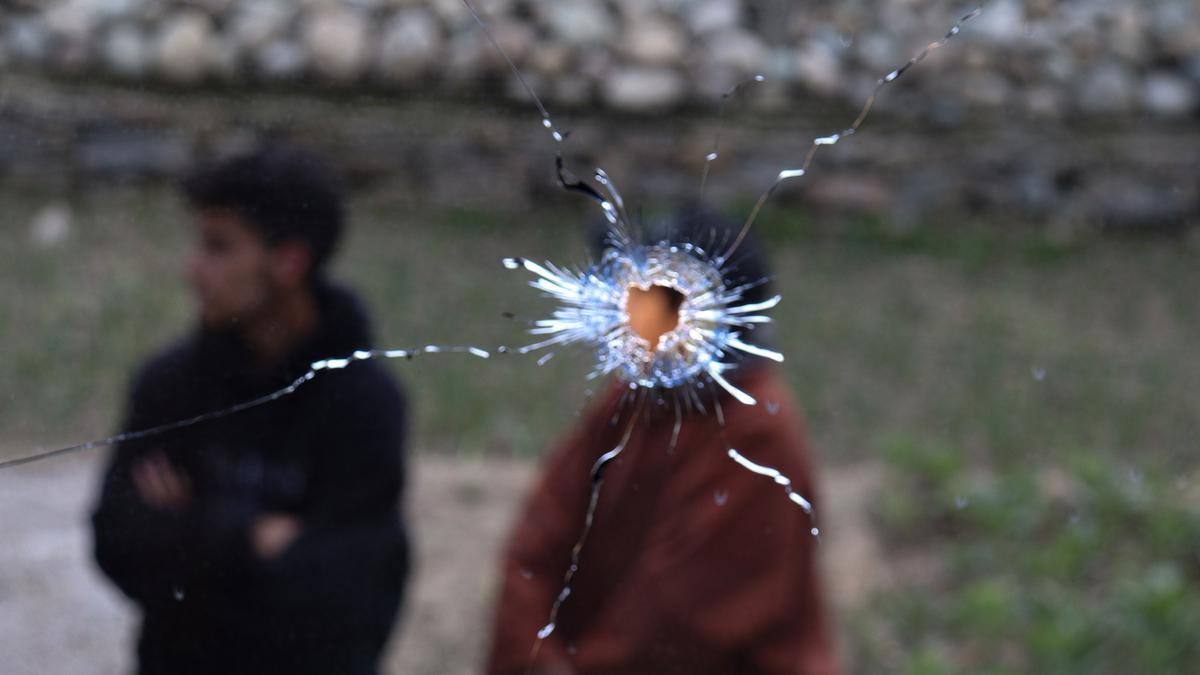Violence in the Kashmir Valley: Bullet-ridden glass after an encounter with security forces that left two terrorists dead two days after a Kashmiri Pandit was killed, in Pulwama on Feb. 28, 2023. An Army jawan was also killed.
Targeted killings against Kashmiri Pandits and minorities in the Kashmir Valley have been on the rise. The death of Kashmiri Pandit and bank guard Sanjay Sharma in Pulwama, late last month, was the latest in a series of attacks against the minority community. These attacks have increased fear in the community and raised concerns about the lack of security. Sharma’s killing was the second such incident against Kashmiri Pandits in Pulwama, the first being Janki Nath’s death in 1990 at the peak of militancy. Sharma’s attacker was killed in a follow-up operation. However, this has done little to allay the fears of the community. All the major political parties in the Valley have condemned the attacks.
In 2022, terrorist attacks left 29 civilians dead, including three local Pandits, three other Hindus and eight non-local labourers in Jammu and Kashmir. The unrest led to 5,500 Pandit employees moving out from the Valley. Since 2022, India has witnessed 315 incidents involving violent murders. Of these, Jammu and Kashmir account for 160 incidents followed by the Maoist insurgency which was responsible for 126 incidents.
Data from the South Asia Terrorism portal show that violence has been on the rise in the Valley, following a period of relative calm between 2011 and 2016 when a total of 562 incidents related to killings took place. In the last six years, however, there have been 948 incidents, close to a 70% rise. Chart 1 shows the number of incidents since 2010 that resulted in fatalities. A killing-related incident is a terrorism-related event which results in at least one death.
Chart 1
Chart appears incomplete? Click to remove AMP mode
After 2016, there has been a spike in the deaths of both civilians and security forces in comparison to the early 2010s. However, deaths among both these sections declined since 2018. SATP records show 30 civilian deaths in 2022. A bulk of them were killings of Kashmiri Pandits and migrants, revealing a dangerous pattern of terrorists seeking to target religious minorities in the Union Territory. Chart 2 shows the number of civilians and security personnel who were killed between 2010 and 2022.
Chart 2
Click to subscribe to our Data newsletter
These attacks have continued despite the administration claiming to provide adequate security to the residents. Casualties among security forces have also occurred during operations against the perpetrators. For instance, an Army jawan died in the operation to flush out the killers of Sharma.
Until 2007, civilian deaths formed a greater proportion of fatalities. In 2008, deaths among security personnel rose and were higher than civilian deaths.
South Kashmir, in particular, has become a hotbed for terror-related civilian deaths. The district-wise share of civilian deaths since 2000 reveals that more such fatalities are taking place in South Kashmir, Budgam and Srinagar in central Kashmir. For example, in 2022, 27% of all civilian deaths occurred in the Shopian district of South Kashmir, where the share was zero until 2006.
In the 2000s, civilian deaths were concentrated in Anantnag, Baramulla, Doda and Srinagar. During the calmer period in the early to mid-2010s, Baramulla continued to see a high number of civilian deaths. These peaked in 2017 at 37% of the total deaths. This was also the time when South Kashmir began to see a rise in civilian deaths, particularly in Pulwama.
From 2017 onwards, attacks on civilians were mostly restricted to South Kashmir. Kulgam and Shopian districts experienced the most civilian deaths, accounting for 20% and 27%, respectively. Chart 3 shows the district-wise share of civilian deaths in Kashmir between 2000 and 2022.
Chart 3
Source: South Asian Terrorism Portal
Also read | Unending ordeal: On the continued civilian killings in Jammu and Kashmir
Listen to our Data podcast: What decides women’s marital age — wealth, education or caste | Data Point podcast




